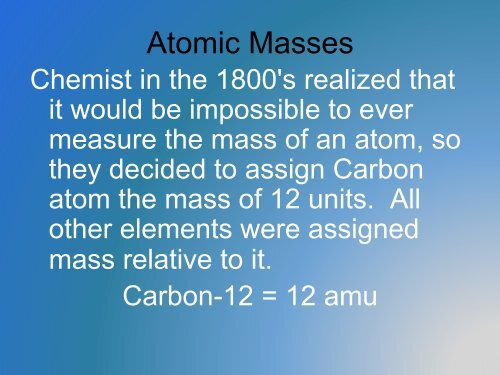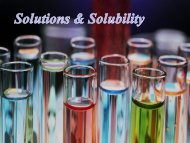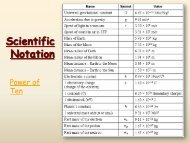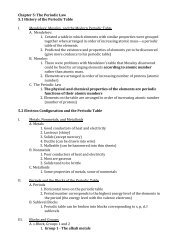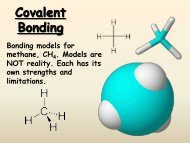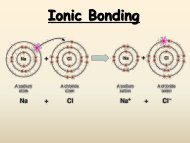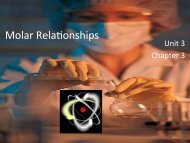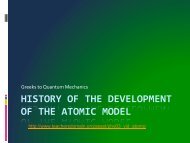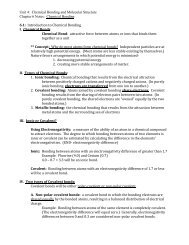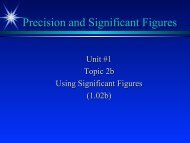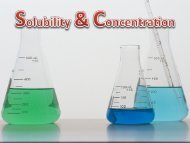You also want an ePaper? Increase the reach of your titles
YUMPU automatically turns print PDFs into web optimized ePapers that Google loves.
<strong>Atomic</strong> <strong>Masses</strong><br />
Chemist in the 1800's realized that<br />
it would be impossible to ever<br />
measure the mass of an atom, so<br />
they decided to assign Carbon<br />
atom the mass of 12 units. All<br />
other elements were assigned<br />
mass relative to it.<br />
Carbon-12 = 12 amu
Average <strong>Atomic</strong> Mass<br />
• weighted average of all isotopes<br />
• on the Periodic Table<br />
• round to two decimal places<br />
Avg.<br />
<strong>Atomic</strong><br />
Mass<br />
=<br />
(mass)(%) + (mass)(%)<br />
(% in decimal form)
q Average <strong>Atomic</strong> Mass (AAM)<br />
This is the weighted average mass of all atoms of<br />
an element, measured in a.m.u.<br />
For an element with<br />
isotopes A, B, etc.:<br />
AAM = Mass A (% A) + Mass B (% B) + …<br />
% abundance<br />
(use the decimal form of the %;<br />
e.g., use 0.253 for 25.3%)
Lithium has two isotopes.<br />
Li-6 atoms have mass 6.015 amu;<br />
Li-7 atoms have mass 7.016 amu.<br />
Li-6 makes up 7.5% of all Li atoms.<br />
Find AAM of Li.<br />
Li batteries<br />
AAM = Mass A (% A) + Mass B (% B)<br />
AAM = 6.015 amu (0.075) + 7.016 amu<br />
(0.925)<br />
AAM = 0.451 amu + 6.490 amu<br />
AAM = 6.94 amu<br />
** Decimal number on Table refers to…<br />
AAM (in amu).<br />
1 average atom
Average <strong>Atomic</strong> Mass<br />
• EX: Calculate the avg. atomic mass of oxygen if its<br />
abundance in nature is 99.76% Oxygen-16, 0.04%<br />
Oxygen-17, and 0.20% Oxygen-18.<br />
AAM = Mass A (% A) + Mass B (% B) + Mass C (%C)<br />
Avg.<br />
<strong>Atomic</strong><br />
Mass<br />
=<br />
(15.995)(.9976) + (16.999)(.00038) + (17.999)(.0020)<br />
= 16.00 amu
100<br />
90<br />
Mass spectrum of chlorine. Elemental chlorine (Cl 2 ) contains<br />
only two isotopes: 34.97 amu (75.53%) and 36.97 (24.47%)<br />
17<br />
Cl<br />
35.4594<br />
Abundance<br />
80<br />
70<br />
60<br />
50<br />
40<br />
30<br />
20<br />
10<br />
Cl-35<br />
AAM = (34.97 amu)(0.7553) + (36.97 amu)(0.2447)<br />
AAM = (26.412841 amu) + (9.046559 amu)<br />
AAM = 35.4594 amu<br />
Cl-37<br />
0<br />
34 35 36 37<br />
Mass
Mass Spectrophotometer<br />
magnetic field<br />
heaviest<br />
ions<br />
stream<br />
of ions of<br />
different<br />
masses<br />
lightest<br />
ions<br />
electron<br />
beam<br />
gas<br />
Dorin, Demmin, Gabel, Chemistry The Study of Matter 3rd Edition, page 138
Mass Spectrometry<br />
Photographic plate<br />
198 200 202<br />
196 199 201<br />
- +<br />
Mass spectrum of mercury vapor<br />
Stream of positive ions<br />
Hill, Petrucci, General Chemistry An Integrated Approach 1999, page 320
Mass Spectrum for Mercury<br />
(The photographic record has been converted to a scale of relative number of atoms)<br />
The percent natural abundances<br />
for mercury isotopes are:<br />
198 200 202<br />
Relative number of atoms<br />
30<br />
25<br />
20<br />
15<br />
10<br />
Hg-196 0.146%<br />
Hg-198 10.02%<br />
Hg-199 16.84%<br />
Hg-200 23.13%<br />
Hg-201 13.22%<br />
Hg-202 29.80%<br />
Hg-204 6.85%<br />
196 199 201 204<br />
Mass spectrum of mercury vapor<br />
5<br />
196 197 198 199 200 201 202 203 204<br />
Mass number
The percent natural abundances<br />
for mercury isotopes are:<br />
A<br />
B<br />
C<br />
D<br />
E<br />
F<br />
G<br />
Hg-196 0.146%<br />
Hg-198 10.02%<br />
Hg-199 16.84%<br />
Hg-200 23.13%<br />
Hg-201 13.22%<br />
Hg-202 29.80%<br />
Hg-204 6.85%<br />
Hg<br />
200.59<br />
80<br />
AAM = (massA)(%A) +(massB)(%B) + (massC)(%C) + (massD)(%D) + (massE)(%E) +<br />
(mass F) (% F)+ (mass G)(% G)<br />
AAM = (196)(0.00146) + (198)(0.1002) + (199)(0.1684) + (200)(0.2313) + (201)(0.1322) + (202) (0.2980) + (204)(0.0685)<br />
AAM = 0.28616 + 19.8396 + 33.5116 + 46.2600 + 26.5722 + 60.1960 + 13.974<br />
AAM = 200.63956 amu
Isotope<br />
U-234<br />
U-235<br />
U-238<br />
Mass<br />
%<br />
abundance<br />
234.04 amu 0.005%<br />
235.04 amu 0.720%<br />
238.05 amu<br />
99.275%<br />
AAM = M A (% A) + M B (% B) + M C (% C)<br />
AAM = 234.04 (0.00005) + 235.04 (0.00720) + 238.05 (.99275)<br />
AAM = 0.011702 + 1.692288 + 236.32491<br />
AAM = 238.0289 amu
Isotope<br />
Si-28<br />
Si-29<br />
Si-30<br />
Mass<br />
%<br />
abundance<br />
27.98 amu 92.23%<br />
28.98 amu 4.67%<br />
<br />
3.10%<br />
AAM = M A (% A) + M B (% B) + M C (% C)<br />
28.086 = 27.98 (0.9223) + 28.98 (0.0467) + X (0.031)<br />
28.086 = 25.806 + 1.353 + 0.031X<br />
28.086 = 27.159 + 0.031X<br />
0.927 = 0.031X<br />
0.031<br />
X = M Si-30 = 29.90 amu<br />
0.031
Hyphen Notation<br />
• Put the mass number after the name of<br />
the element<br />
• Carbon- 12<br />
• Uranium- 235<br />
• Chlorine- 35<br />
• Hydrogen- 2
<strong>Atomic</strong> Mass<br />
Calculate the atomic mass of copper if copper has two isotopes.<br />
69.1% has a mass of 62.93 amu and the rest has a mass of<br />
64.93 amu.<br />
Isotope<br />
Percent<br />
Abundance<br />
Mass<br />
Cu-63 69.1 62.93<br />
Cu-65 30.9 64.93<br />
AAM = Mass A (%A) + Mass B (%B)<br />
AAM = 43.48463 + 20.06337<br />
AAM = 63.548 amu<br />
43.48463<br />
20.06337<br />
63.548<br />
Cu 29<br />
63.548


